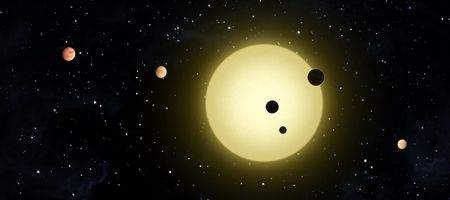NASA believes it’s discovered its first Earth-sized exoplanets – and five of them are in the ‘Goldilocks zone’ where conditions are considered favorable for life.

The Kepler mission has also found six confirmed planets orbiting a sun-like star, Kepler-11 – the largest group of transiting planets orbiting a single star yet discovered outside our solar system.
“We went from zero to 68 Earth-sized planet candidates and zero to 54 candidates in the habitable zone – a region where liquid water could exist on a planet’s surface. Some candidates could even have moons with liquid water,” said the mission’s science principal investigator, William Borucki. “Five of the planetary candidates are both near Earth-size and orbit in the habitable zone of their parent stars.”
The discoveries are just some of a huge number of newly-identified planet candidates; and all still need confirming. But they increase the number of planet candidates found by Kepler to 1,235. Of these, 68 are roughly Earth-size; 288 are super-Earth-size; 662 are Neptune-size; 165 are the size of Jupiter and 19 are larger than Jupiter. They’ve all been found in one small area covering about one four-hundredth of the sky.
Of the 54 new planet candidates found in the habitable zone, five are near Earth-sized. The remaining 49 habitable zone candidates are all much larger.
“The fact that we’ve found so many planet candidates in such a tiny fraction of the sky suggests there are countless planets orbiting sun-like stars in our galaxy,” said Borucki. “We went from zero to 68 Earth-sized planet candidates and zero to 54 candidates in the habitable zone, some of which could have moons with liquid water.”
Kepler-11, around 2,000 light years from Earth, is the most tightly packed planetary system yet discovered. All six of its confirmed planets have orbits smaller than Venus, and five have orbits smaller than Mercury’s. The only other star with more than one confirmed transiting planet is Kepler-9, which has three.
“Kepler-11 is a remarkable system whose architecture and dynamics provide clues about its formation,” said Jack Lissauer, a planetary scientist and Kepler science team member at Ames.
“These six planets are mixtures of rock and gases, possibly including water. The rocky material accounts for most of the planets’ mass, while the gas takes up most of their volume. By measuring the sizes and masses of the five inner planets, we determined they are among the lowest mass confirmed planets beyond our solar system.”
“In one generation we have gone from extraterrestrial planets being a mainstay of science fiction, to the present, where Kepler has helped turn science fiction into today’s reality,” said NASA administrator Charles Bolden. “These discoveries underscore the importance of NASA’s science missions, which consistently increase understanding of our place in the cosmos.”






